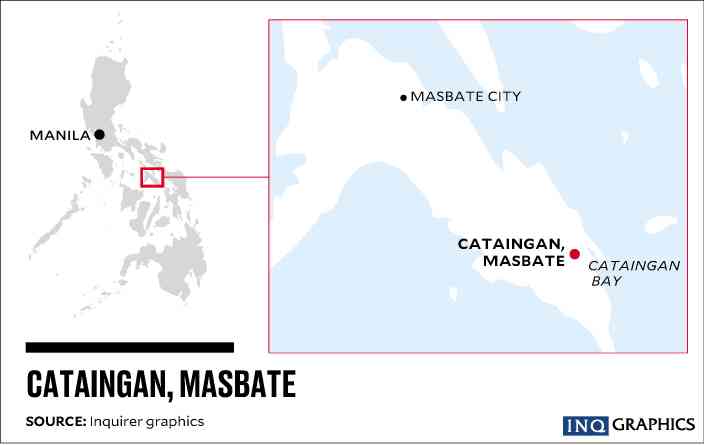Masbate earthquake: They saw it coming
I have written about major seismic events in the Inquirer, devastated areas where earthquakes were least expected, either in places where active faults were unknown, like in Negros (6.9 magnitude, February 2012), Bohol (7.2 magnitude, October 2013) and Zambales (6.1 magnitude, April 2019), or where the faults were not expected to generate more than one large earthquake within a short period of time and over a small geographic area, such as in Cotabato (October 2019, four 6-magnitude earthquakes occurring in two weeks).
In contrast, the 6.6-magnitude quake that struck Cataingan Bay in Masbate on Aug. 18 was quite expected — and students doing on-the-job training (OJT) actually saw it coming!
Early in 2017, Crystel, Pamela and Elisha, geology students of Adamson University, approached us at our research lab on structural geology and tectonics at the University of the Philippines’ National Institute of Geological Sciences (UP-NIGS). They were scouting for a host for their OJT, a requirement for their bachelor’s degree.
JD, then my research associate (RA), welcomed the three students who were later joined by a fourth, John Paul, and began initiating them in earthquake studies. But JD had to leave shortly to pursue his Ph.D. at Oxford University in the United Kingdom. So Jagu, who succeeded JD as my RA, took the brunt of advising our trainees.
CST theory
Crystel and classmates wanted to work on a problem that involved earthquakes generated by the Philippine Fault, the longest and most destructive active fault in the country. It caused the devastating 7.8-magnitude Luzon earthquake of July 16, 1990, where a fault segment of about 110 kilometers long ruptured. It is the strongest on-land tremor recorded in the past 100 years.
Throughout the fault’s overall length of more than 1,200 km, there are other segments that have also ruptured and caused devastating earthquakes in recent years. Crystel and classmates wanted to understand if these earthquakes occurring at different segments were related to each other, by employing the Coulomb Stress Transfer (CST) theory.
The theory revolves around the idea that as a segment slips, the generated earthquake is the fault’s manner of releasing the stresses that have accumulated over time.
That rupturing segment is thus said to experience stress decrease and is believed to stay seismically quiet for some time. The released stresses do not disappear but instead transfer to another location, to an area said to experience stress increase.
If a fault exists in the stress increase region, then that fault is likely to be the next to slip and generate the next earthquake.
The CST method is a promising technique that can be very useful in earthquake disaster risk reduction and management.
Best undergrad thesis
In March 2018, Crystel and classmates submitted their undergraduate thesis titled: “Investigation of stress changes along the Philippine Fault Zone using Coulomb Stress Transfer modeling.” Their thesis was adjudged the best undergraduate thesis of that year by their school department; it also reaped honors as best paper and best oral presentation in some of their school’s culminating scientific forums.
In December 2018, their work was accepted for presentation at the annual national congress for geologists, a rarity for an undergraduate research given that this scientific conference is normally reserved for the presentation of work by academics in graduate education and professionals in specialized fields.
In their thesis, the students processed and analyzed Philippine Fault earthquakes generated by its different segments from Luzon to Mindanao between 1976 and 2017.
One focus was the Masbate segment in central Philippines, where the fault splits in two into the main branch to the east and the Sibuyan Sea Fault to the west. The interaction between these two faults partly contributes to the elevated seismicity on the island, rendering it highly prone to earthquakes.
Trigger
What could have triggered the Aug. 18 earthquake?
On Feb. 15, 2003, a 6.3-magnitude earthquake struck central Masbate with the epicenter located in Uson Bay. CST modeling suggests that this earthquake transferred stress toward the southeast, in the direction of Cataingan Bay.
This suggests that the Aug. 18 earthquake was possibly triggered by the 2003 event — a case where nature obeys theory.
But Crystel and classmates recognized this relationship as early as two years ago. On page 34 of their 2018 thesis, they state: “The Feb. 15, 2003 earthquake [produced] significant stress increase of 1 to 0.3 bars … in Cataingan and Pio V. Corpuz,” seemingly enough to cause slippage of that segment last Aug. 18.
In a way, Crystel and classmates had seen it coming.
Aptly, Crystel now works as an earthquake researcher at the Philippine Institute of Volcanology and Seismology. Her former classmates are likewise employed in the industry and the government.
* * *
Mario A. Aurelio, Ph.D., is a professor at the University of the Philippines and current director of UP-NIGS, where he heads the Structural Geology Laboratory. Among his research interests are active faults and earthquakes.
